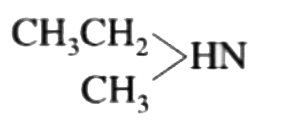Which of the following volatile?
CH3CH2CH2NH2
(CH3)3N

CH3−CH2−OH
The correct Answer is:B
To determine which of the given compounds is volatile, we need to analyze the boiling points of each compound, as volatility is inversely related to boiling point. A lower boiling point indicates higher volatility.
1. Understanding Volatility:
- Volatility refers to the tendency of a substance to vaporize. A substance is considered volatile if it has a low boiling point, allowing it to evaporate easily.
2. Analyzing the Compounds:
- We will examine each option to determine their boiling points and the presence of hydrogen bonding, which affects volatility.
3. Option 1: CH3CH2CH2NH2 (1-degree amine):
- This compound can form hydrogen bonds due to the presence of an NH2 group. Hydrogen bonding increases the boiling point, making it less volatile.
4. Option 2: CH3N(CH3)2 (3-degree amine):
- This is a tertiary amine and does not have hydrogen atoms attached to the nitrogen that can participate in hydrogen bonding. Therefore, it has a lower boiling point and is more volatile compared to the 1-degree amine.
5. Option 3: CH3NH(CH3) (2-degree amine):
- This compound has one hydrogen atom that can participate in hydrogen bonding. While it is less volatile than the tertiary amine, it is still more volatile than the 1-degree amine due to its lower boiling point compared to the 1-degree amine.
6. Option 4: CH3CH2OH (Ethanol):
- Ethanol can also form hydrogen bonds due to the presence of the hydroxyl (OH) group. This results in a higher boiling point, making it less volatile.
7. Conclusion:
- Among the options analyzed, the tertiary amine (Option 2: CH3N(CH3)2) has the lowest boiling point and is therefore the most volatile compound.
Final Answer:
The volatile compound is Option 2: CH3N(CH3)2 (3-degree amine).
- Volatility refers to the tendency of a substance to vaporize. A substance is considered volatile if it has a low boiling point, allowing it to evaporate easily.
- We will examine each option to determine their boiling points and the presence of hydrogen bonding, which affects volatility.
- This compound can form hydrogen bonds due to the presence of an NH2 group. Hydrogen bonding increases the boiling point, making it less volatile.
- This is a tertiary amine and does not have hydrogen atoms attached to the nitrogen that can participate in hydrogen bonding. Therefore, it has a lower boiling point and is more volatile compared to the 1-degree amine.
- This compound has one hydrogen atom that can participate in hydrogen bonding. While it is less volatile than the tertiary amine, it is still more volatile than the 1-degree amine due to its lower boiling point compared to the 1-degree amine.
- Ethanol can also form hydrogen bonds due to the presence of the hydroxyl (OH) group. This results in a higher boiling point, making it less volatile.
- Among the options analyzed, the tertiary amine (Option 2: CH3N(CH3)2) has the lowest boiling point and is therefore the most volatile compound.
The volatile compound is Option 2: CH3N(CH3)2 (3-degree amine).
Topper's Solved these Questions
Similar Questions
Knowledge Check
Which of the following is a volatile memory ?
AEPROMBEEPROMCDVDDSRAMWhich of the following would lead to an increase in the vapour pressure of a liquid ?
(P) Increasing the temperature
(Q) Adding a non-volatile soluteAP onlyBQ onlyCBoth P and QDNeither P nor QWhich of the following explanations accounts for o-nitro-phenol to be more volatile than p-nitrophenol?
AIntermolecular hydrogen bondingBResonanceCIntramolecular hydrogen bondingDInductive effect

